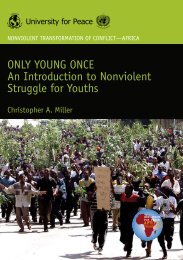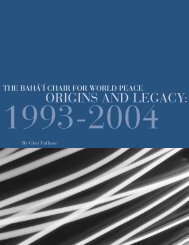FOOTNOTES1It is not my purpose here to discuss <strong>in</strong> detail the media coverage; most can f<strong>in</strong>dup-to-date <strong>in</strong>formation via Google. From my experience, the most accessible andreliable source is Human Rights Watch, while Dr. Reeves provides daily analyses. Seealso, Sudan Focal Po<strong>in</strong>t-Africa by John Ashworth and Justice Africa’s Prospects forPeace <strong>in</strong> Sudan by Alex deWaal.2A personal caveat needs to be entered here. I did fieldwork <strong>in</strong> Darfur between 1968and 1977; my primary focus w<strong>as</strong> on the pre-colonial history <strong>of</strong> the region. I havepublished three books and some fifty articles on the history and culture <strong>of</strong> Darfur,but it is important to emph<strong>as</strong>ise that I did my research before the mid-1980s whendrought and desertification began to br<strong>in</strong>g about far-reach<strong>in</strong>g <strong>environmental</strong>,demographic and political changes.3From the Arabic, jann (j<strong>in</strong>n) ‘spirit, devil’ and jawad ‘horse’.4See the two fundamental articles <strong>of</strong> Gunnar Haaland, ‘Economic determ<strong>in</strong>ants <strong>in</strong>ethnic processes’, <strong>in</strong> Ethnic Groups and Boundaries, ed. F. Barth, London 1969,58-73, and ‘Nomadism <strong>as</strong> an economic career among the sedentaries <strong>of</strong> the SudanSavanna Belt’, <strong>in</strong> Essays <strong>in</strong> Sudan Ethnography, eds. I. Cunnison & W. James, London1972, 149-72. On the creation <strong>of</strong> identity from a different perspective, see O’Fahey& H<strong>as</strong>an Imam H<strong>as</strong>an, ‘Notes on the Mileri <strong>of</strong> Jabal Mun’, Sudan Notes and Records,li, 1970, 152-61.5See my State and Society <strong>in</strong> Darfur, London 1980.6The ethnographic and historical data is exceptionally rich. The ma<strong>in</strong> collections<strong>in</strong>clude the papers <strong>of</strong> the Rev. Dr. A.J. Arkell from the 1920s & 30s (c. 2,400pages; School <strong>of</strong> Oriental and African Studies, London); the manuscripts <strong>of</strong> a selftaughtSudanese historian, Muhammad ‘Abd al-Rahim (<strong>in</strong> Arabic; National RecordsOffice, Khartoum); the several hundred documents and decrees (the earliest fromc. 1710) that I photographed <strong>in</strong> the 1970s (copies <strong>in</strong> Bergen and Khartoum)); theseveral hundred pages <strong>of</strong> notes I made from the Prov<strong>in</strong>ce colonial archives <strong>in</strong> thesame period, which archives were subsequently destroyed by accident dur<strong>in</strong>g theal-Numayri era [copies <strong>of</strong> my notes are accessible <strong>in</strong> Khartoum and Bergen], and myfield-notes. It would be possible to write <strong>in</strong> detail on the sultans and their attitudeto the environment, a theme I neglected <strong>in</strong> my writ<strong>in</strong>gs. I hope <strong>in</strong> the years tocome to put <strong>as</strong> much <strong>of</strong> this material <strong>as</strong> possible on the Web.7State and Society, 98-99.8See my ‘The Conquest <strong>of</strong> Darfur, 1873-1882’, Sudan Notes and Records, N.S. 1, 1998,47-67. Some <strong>of</strong> al-Zubayr’s arguments justify<strong>in</strong>g his conquest <strong>of</strong> a Muslim statehave their echoes today.9See further A.B. Theobald, ‘Ali D<strong>in</strong>ar:L<strong>as</strong>t Sultan <strong>of</strong> Darfur, 1898-1916, London 1965.10See R.S. O’Fahey and M.I. Abu Salim, Land <strong>in</strong> Dar Fur, Cambridge 1983.30
11See further Joerg Adelberger, Vom Sultanat zur Republik. Veranderungen <strong>in</strong> derSozialorganisation der Fur. Stuttgart 1990.12In much <strong>of</strong> what follows an authoritative guide is Dougl<strong>as</strong> H. Johnson, The RootCauses <strong>of</strong> Sudan’s Civil Wars, Oxford 2003. This provides an <strong>in</strong>dispensable analyticaland bibliographical guide to the topics discussed here.13I met <strong>in</strong> al-F<strong>as</strong>hir <strong>in</strong> 1970 the late Dr. Ja’far ‘Ali Bakhit, the then M<strong>in</strong>ister <strong>of</strong> LocalGovernment and one <strong>of</strong> the <strong>in</strong>dependent <strong>in</strong>tellectuals around al-Numayri [he w<strong>as</strong>pr<strong>of</strong>essor <strong>of</strong> political science at the University <strong>of</strong> Khartoum]. I argued with himthat his policy w<strong>as</strong> a mistake; he agreed <strong>in</strong>tellectually, but there w<strong>as</strong> a political imperativeat work. He had written his doctorate at Cambridge on <strong>in</strong>direct rule underthe British.14See Alex de Waal, Fam<strong>in</strong>e that Kills: Darfur, Sudan, 1984-1985, Oxford 1989. Foran earlier study that foresaw much <strong>of</strong> what happened soon after, see Fouad N.Ibrahim, Ecolological Imbalance <strong>in</strong> the Republic <strong>of</strong> the Sudan, with references toDesertification <strong>in</strong> Darfur, Bayreuth 1984.15For a description <strong>of</strong> a successful mediation between the Rizayqat and the BaniHalba by the late Dr. M.I. Abu Salim and his friend, Ja’far ‘Ali Bakhit, see M.I. AbuSalim, Fi’l-shakhsiyat al-Sudaniyya [Concern<strong>in</strong>g Sudanese Personalities], Khartoum1979.16See on this period, James Morton, ‘Tribal adm<strong>in</strong>istration or no adm<strong>in</strong>istration: thechoice <strong>in</strong> Western Sudan’, Sudan Studies, 11, January 1992,17Heather Sharkey, Liv<strong>in</strong>g with Colonialism. Nationalism and Culture <strong>in</strong> the Anglo-EgyptianSudan, Los Angeles, 2002.18We have several thousand such documents <strong>in</strong> Bergen and I <strong>in</strong>tend to publish <strong>as</strong>tudy <strong>of</strong> the descriptions, awsaf, <strong>in</strong> the future. On colour-cod<strong>in</strong>g, see R.S. O’Fahey& Jay L. Spauld<strong>in</strong>g, K<strong>in</strong>gdoms <strong>of</strong> the Sudan, London 1974, 30-31. I give someexamples:—Quantity 1 slave: her name Halima, Tamawiyya [from Dar Tama]: yellow: <strong>of</strong> mediumheight: valuable.The woman (al-adamiyya): called Khadimallah: locally born: red by colour: crippled:<strong>of</strong> medium height.The woman: called Fadl: locally born by nationality [al-j<strong>in</strong>s]: green by colour: <strong>of</strong>medium height: scarified <strong>in</strong> the local manner.19See Human Rights Watch, Darfur Destroyed, May 2004. This I f<strong>in</strong>d very difficult tounderstand. The Sufi brotherhoods <strong>in</strong> Darfur, the predom<strong>in</strong>ant Muslim organisations<strong>in</strong> the prov<strong>in</strong>ce, primarily the Tijaniyya, are racially bl<strong>in</strong>d. I can not envisage thelate Ibrahim Sidi, Darfur’s most respected Tijani shaykh (d. 2000), tolerat<strong>in</strong>g suchracism.31
- Page 1: ENVIRONMENTAL DEGRADATIONAS A CAUSE
- Page 4 and 5: Cover Photo:AU forces patrol Darfur
- Page 7 and 8: PREFACEThese essays were originally
- Page 9 and 10: AcknowledgementsThe conference was
- Page 11 and 12: Executive SummaryByMary E. King and
- Page 13 and 14: the theme of the conference, outlin
- Page 15 and 16: • The question of warrior culture
- Page 17 and 18: Deryke Belshaw, University of East
- Page 19 and 20: area in West Darfur of 1.5m feddans
- Page 21 and 22: on the interaction between conflict
- Page 23 and 24: Conflict In DarfurHistorical andCon
- Page 25 and 26: distributive centre and where the r
- Page 28 and 29: sues quite separate. Evidence for t
- Page 32 and 33: 20On other emerging ethnically-base
- Page 34 and 35: IntroductionTHE Greater Darfur regi
- Page 36 and 37: 2. Agriculture (Farming)Crop farmin
- Page 38 and 39: Secondly, the demand for mutton and
- Page 40 and 41: groundnut and sesame as sources of
- Page 42 and 43: The situation of drinking water in
- Page 44 and 45: ReferencesConference, Meleet, North
- Page 46 and 47: IntroductionTHE residents of the Um
- Page 48 and 49: Phase Two:This phase was a monitori
- Page 50 and 51: zone southward — and to use these
- Page 52 and 53: • Some water points in places lik
- Page 54 and 55: This study and the seminar organize
- Page 57 and 58: Land Tenure,Land Use andConflicts i
- Page 59 and 60: tain innovations called hakura (pl.
- Page 61 and 62: mands for food production. All thes
- Page 63 and 64: Hashab Tenure SystemHashab ownershi
- Page 65 and 66: co-exist at the local level where e
- Page 67 and 68: IndigenousInstitutions andPractices
- Page 69 and 70: abs. In the past they had been invo
- Page 71 and 72: Sufi OrderSufi orders are religious
- Page 73 and 74: Native Administration, i.e. Tribal
- Page 75 and 76: Rizayqat homeland is at the extreme
- Page 77 and 78: esearchers and statesmen. A bigger
- Page 79: ReferencesBakheit, Jaafar M.Ali. 19
- Page 82 and 83:
IntroductionWHILE in the Sudan prot
- Page 84 and 85:
ReferencesHarir, S. 1993. ‘Arab B
- Page 86 and 87:
IntroductionTHE Darfur Region lies
- Page 88 and 89:
Table (1)Water program for Darfur 2
- Page 90 and 91:
anging from 150mm the north and 450
- Page 92 and 93:
ReferencesIbrahim, Abdel Rahman Abb
- Page 94 and 95:
CONCLUSIONTHE collection of papers
- Page 96 and 97:
GLOSSARYAjawidArdaBaqqaraDarDukhnFa
- Page 99 and 100:
A Darfur Timeline99
- Page 101 and 102:
1898 On the eve of the battle of Om
- Page 103 and 104:
Bibliography103
- Page 105 and 106:
El Mahdi S. Mohamed. 1979. Introduc
- Page 107 and 108:
Tothill, J.D. 1948. Agriculture in
- Page 109 and 110:
Biographical Sketch: Rex Sean O’F
- Page 111 and 112:
111











